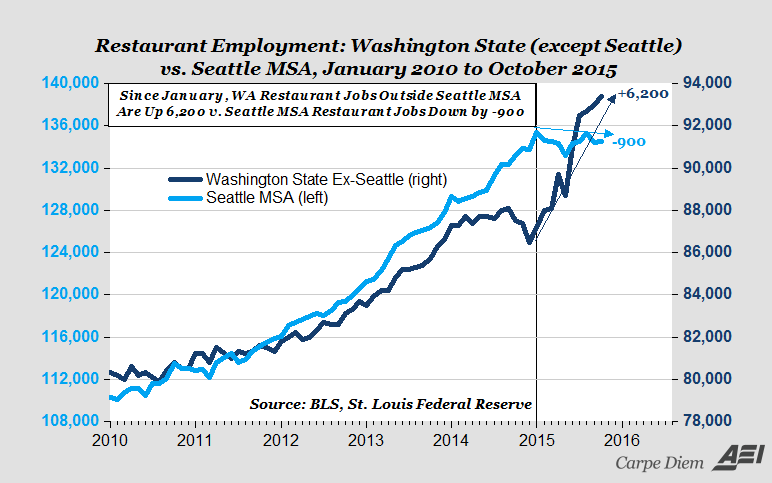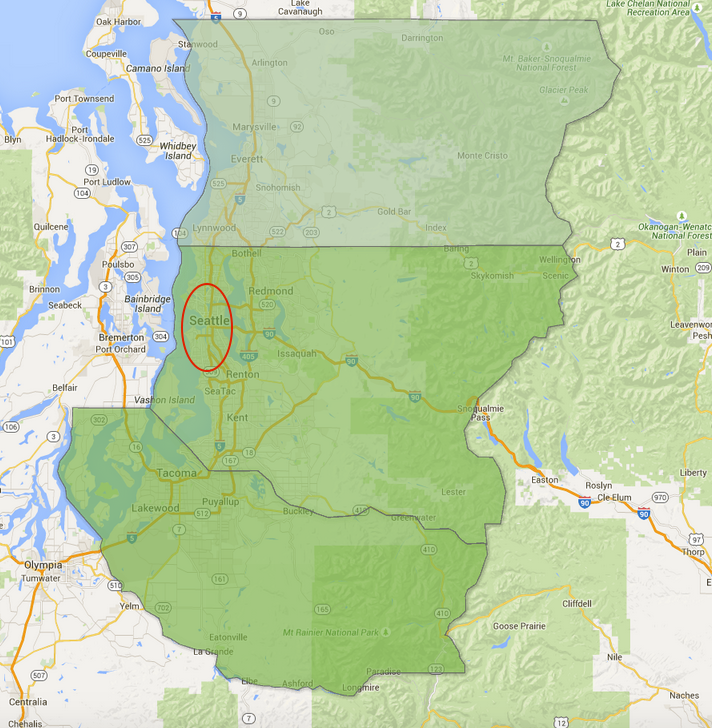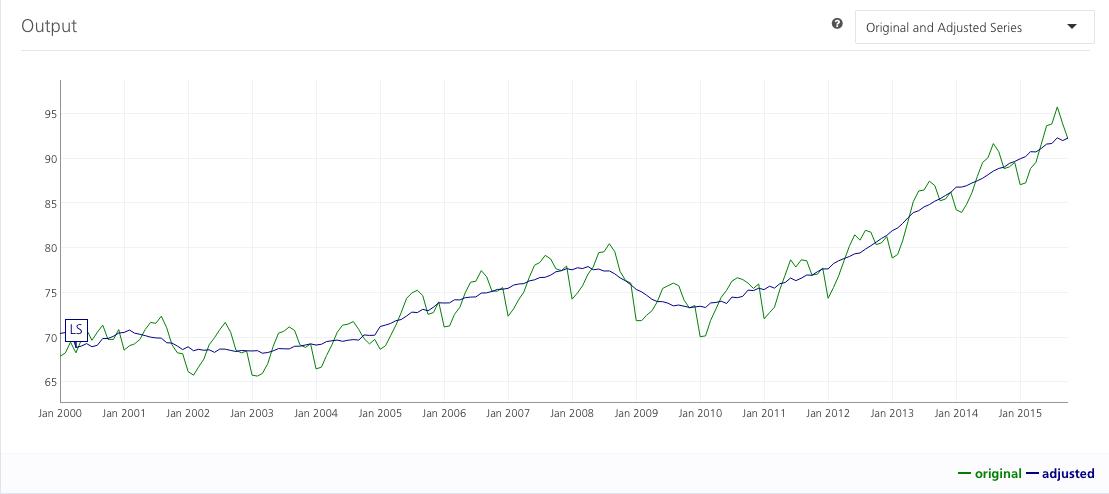@TBPInvictus here
The City of Seattle’s minimum wage is now $11, going up to $15 for some employers by 2020. Mark Perry has posted his monthly missive on how April’s minimum wage hike is destroying restaurant employment there:
I’ve pointed out ad nauseam that this larger region is irrelevant to any discussion of the minimum wage debate. While the min wage has gone up in the City of Seattle, that may or may not have an impact on the entire — and many times larger — Seattle MSA.
The Seattle-Tacoma-Bellevue Metropolitan Statistical Area (MSA) that Perry likes to harp on is comprised of three counties – King (in which Seattle resides), Pierce, and Snohomish. The MSA has a population of some 3.6 million versus the city’s population of about 660,000. In other words, almost 3 million people, or about 72% of the total, reside (and likely work) outside the area are where the minimum wage was hiked.
To use this as the basis of a minimum wage critique is either incredibly ignorant or purposefully misleading. It does not reflect well on its authors. This inexcusable approach means that AEI has been party to what is an obviously false analysis. That is why amongst knowledgeable analysts, AEI are known as a “Stink Tank.” Everything they produce comes with the stank of its dubious validity and questionable intellectual honesty.
AEI seems to have finally figured out that obviously lying about data is going to get them called out as the fabricators they have unfortunately morphed into: The most recent post by Perry includes a disclaimer indirectly admitting this entire line of argument has been a scam. There has not been the sort of intellectual honesty where one admits error — no mea culpa like BR does — but instead a “Technical Note” at the end of the post essentially explaining why the entire post is utter nonsense. I assume AEI forced this on Perry in order to protect their already damaged reputation.
Technical Note: The BLS restaurant employment data for the Seattle MSA covers the entire metro area of 3.6 million people, while the population in the city of Seattle, which is the only part of the MSA that is subject to the eventual $15 an hour minimum wage, is only about 652,000. Therefore there are several possibilities when considering the loss of 900 restaurant jobs this year . . .
Even that is not a fair and honest disclaimer, as it posits a number of possible scenarios, rather than admit that the MSA is not relevant to the City of Seattle. We just don’t have sufficient data to draw a conclusion.
As I’ve said all along, there are simply no inferences to be made about the city from the MSA. But don’t take my word for it – here (again) is what regional economist Annaliese Vance-Sherman had to say about it:
It is not possible to draw conclusions about the city based on the MSA.
I think it is important to remember that the $15 minimum wage was a city-level ordinance. The City of Seattle falls within a large urban county (King County), which consists of 39 cities including Seattle. In turn, the county is one of three large urban counties that make up the Seattle MSA.
People from the City of Seattle are not going to drive two counties north or south, or cross the mountains, for a burger. If there is a border effect, it would be well within the MSA (well within the boundaries of the county, actually), and would register as a net zero change.
Without re-creating the chart, what could be showing up in this chart is that the recovery in Seattle has been stronger (and earlier) than the remainder of the state. The increased momentum in hiring could be representative of the relatively delayed recovery outside of the Seattle MSA.
For those who may (inexplicably) be new to this issue, here’s a map of the aforementioned tri-county area:
Sadly for Perry, who has married his original bad analysis and refuses to do any further investigating, there is more accurate data out there on employment in the state of Washington, compiled by the Employment Security Department of Washington State. At their site, we can explore and examine each of the counties on a stand alone basis.
To be clear here, I’m not suggesting that even looking at King County itself tells us much about the city of Seattle (one of only 39 municipalities in the county), but it has to be an improvement over looking at a three county behemoth like the Seattle-Tacoma-Bellevue MSA.
As the ESD explains about their data (emphasis mine):
How are these employment estimates different from Current Employment Statistics (CES) employment estimates?
To develop our employment estimates for Washington industries, we replace CES survey data with data from the Quarterly Census of Employment and Wages (QCEW). QCEW data are actual counts of employees, while CES data come from a survey of employers.
Each month, economists estimate monthly job gains and losses based on the survey of employers (CES). Then, at the end of each quarter, economists revise the estimates based on actual numbers from employer tax records (QCEW). The process that replaces employment estimates with the actual number of job gains or losses is called benchmarking. While we benchmark our data quarterly, the BLS benchmarks its data only once a year.
By benchmarking our data quarterly rather than annually, we can provide the most accurate and current information possible on Washington’s economy and labor market.
What is the data source of the report?
The basis of our industry employment estimates is CES.
So, we’ve got a source for more accurate data – benchmarked quarterly instead of annually – and the ability to break the MSA down and look at its component counties. What does that tell us?
Well, if we get the NAICS 722 numbers (Food Services and Drinking Places) – not seasonally adjusted – and then apply a seasonal adjustment, we get a graph that looks as follows, where green represents the raw NSA data from ESD, and the smoother blue line represents that data with a seasonal adjustment.
(Sources: Data – Washington State Employment Security Department, Seasonal Adjustment at seasonal.website)
In terms of numbers, King County finished 2014 with 89,700 NAICS 722 workers (seasonally adjusted), and now has 92,300, for a 2015 YTD gain of 2,600 – a far cry from the 900 Perry claims the MSA has lost. (I pointed out in September that it’s Pierce County that appears to be the problem area of the three.)
Takeaways:
- King County has added, seasonally adjusted, 2,600 NAICS 722 jobs in 2015
- Looking at the Sea-Tac-Belle MSA continues to be futile for divining any information about the city of Seattle proper
- Pierce County appears to be the trouble spot in terms of NAICS 722 jobs
Perry is – as he has been all along – grasping at straws. We will not know with any certainty how Seattle’s experiment plays out for years to come. And when we do, it will likely be from academic studies like this one being undertaken at the University of Washington, which will hopefully factor in all the moving parts, e.g. rising rents, the fact that Seattle is already #2 in the country in eateries per capita, etc. The issue is far more complex than ideologues like Perry would have their audience believe. But Perry’s misbegotten droppings get picked up and circulated throughout the conservative echo chamber, occasionally making their way on to Fox News (Stuart Varney: “You don’t trust the numbers? Those are hard numbers – 1,000 jobs gone. I mean, that’s, they didn’t make it up.” Actually, they may as well have.) This is all by design, of course – Perry’s the guy with a sufficient ability to torture the data and get his results onto the talking points conveyor belt, from which they are subsequently picked up and echoed.
Finally, I would point readers to this recent piece by Bethany Jean Clement at the Seattle Times. Here, in my opinion, is the money shot:
The Washington Restaurant Association recently reported that outlying areas are raising wages to compete with Seattle’s rising minimum, rather than restaurants fleeing the city as some feared.





But if they get all the Republicans on the same page, on the same day, repeating the same thing then enough proud Americans who loudly proclaim how their ideology is right will shout down data, rationality and facts.
Invictus, I appreciate your fine work on this. Just one technical note: I think you meant the noun “stench” instead of the past tense verb “stank” where you write “the stank”. The error probably occurred during final re-write.
“For example, Econ 101 theory tells us that minimum wage policies should have a harmful impact on employment. Basic supply and demand analysis says that in a free market, wages adjust so that everyone who wants a job has a job — supply matches demand. Less productive workers earn less, but they are still employed. If you set a price floor — a lower limit on what employers are allowed to pay — then it will suddenly become un-economical for companies to retain all the workers whose productivity is lower than that price floor. In other words, minimum wage hikes should quickly put a bunch of low-wage workers out of a job.
“That’s theory. Reality, it turns out, is very different. In the last two decades, empirical economists have looked at a large number of minimum wage hikes, and concluded that in most cases, the immediate effect on employment is very small. It’s only in the long run that minimum wages might start to make a big difference”
http://www.bloombergview.com/articles/2015-11-24/most-of-what-you-learned-in-econ-101-is-wrong
Yes and the failure in that Econ 101 narrative is that the actual constriction in the actual real world economy is demand (and has been for at least 4 decades). Regardless of how low the price of labor become, nobody will hire someone unless there is a demand for the product produced by said new employee. However, when you hire people at excessively low wages they cannot produce demand for anything except the most basic survival products. For anybody with just basic logic sense it should come as no surprise that the increased demand from minimum wage people who get a raise (and quickly spend all that new income), will more than counter-balance the negative effects. I mean what are you expecting those employers to do when their wage cost increase? – not produce the product and let their competitors take that market share?
They never seem to realize that their results and indeed most Econ 101 results presuppose a totally free and open market AT EQUILIBRIUM. How often is a market in equilibrium? Is the US stock market, for example, EVER in equilibrium?
DeDude: Your argument is for the aggregate economy, but any individual firm can profit by lowering wages. There is not a free and open labor market, so the workers will not instantly quit and go elsewhere because there is nowhere else to go. Not even the unemployment line if you quit. I believe this is called the Tragedy of the Commons. THAT’s why minimum wage legislation is necessary. It wouldn’t be in Econ 101’s theoretical perfect market always in equilibrium.
One of those right wingers famously said “we create our own reality”. Boy was he right. Within the Fox Bot net they just say it, and then it becomes true for millions of little obedient bots.
I think it is very saying that the areas that compete directly with Seattle for employees are raising wages. That makes sense because workers are a lot more mobile (and easily willing to go another 5-10 miles for a better wage), than customers. If I am grabbing some fast food for lunch, I would not even go another 2 blocks.
The aide said, “That’s not the way the world really works anymore,” he continued. “We’re an empire now, and when we act, we create our own reality. And while you’re studying that reality—judiciously, as you will—we’ll act again, creating other new realities, which you can study too, and that’s how things will sort out. We’re history’s actors…and you, all of you, will be left to just study what we do.”
“Faith, Certainty and the Presidency of George W. Bush,” New York Times Magazine (October 17, 2004) by Ron Suskind, quoting an unnamed aide to George W. Bush (later attributed to Karl Rove)
*One of my ‘favorite’ citations /sarcasm but also the source of a useful label.
Yes and I am sure that it was indeed Karl Rowe. That perfect mix of ignorance, arrogance and plain stupidity would fit perfect with Turd Blossom.
Another great article on the AEI liars over this issue, but “ad nauseam”, please, not “ad nauseum”. Not all latin accusatives end in “um” and this one certainly doesn’t.
Thanks!
Corrected. And thank you.